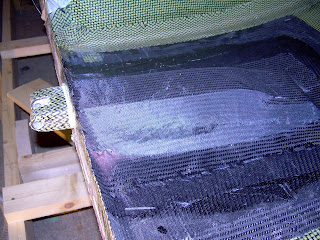
Then I had success in removing the mold plates, some of the releasewax must have survived from laminating in port hull. Then I cut away and sanded the aft beam bulkhead access hole:

Then I started fitting the chain plate. First cutting the hole in the deck flange and aligning according to plan:

Then I bedded the chain plate in high density putty (epoxy and microfibers) and started to build up around the chain plate. When almost cured I made up a new batch of putty with some microballoons in it as well this time to get a smooth shape before laying down the 45/45 fabric. One extra layer on this side as well, a total of 600 g carbon. Wetted out, added peel ply, release film, bleeder and put it all under vacuum:

Unfortunately, I was forced to buy the fast hardener for the Ampreg 20 system I'm using for hand lay ups as that was the only available (I'll get more slow at the end of this week, supposedly) and this led to a race against the clock all day (and when laying up the beam bulkhead flanges yesterday as well) but I was pleased with the final result:

Then it was time to unwrap my experiment with the carbon tubes. Removing the vacuum bag, RDM and release film was just a walk in the park.

But releasing the carbon tube from the PVC tube was close to impossible even though I thoroughly waxed the tube before lamination yesterday. I ended up cutting the laminate on two sides of the tube (before epoxy was fully cured, just become hard, curing of the infusion epoxy until reasonable stiffness takes days in 20 deg Celcius) and then cm by cm releasing the halves from the PVC tube with a sharp knife. I ended up with two "halfpipes", one to sit on each of the storage compartment's walls:
 Even though this was a lot more difficult than anticipated it ended up as two pieces I can use for the intended purpose. But I have to find a better way to make the other two. Here's a close up of the "halfpipes":
Even though this was a lot more difficult than anticipated it ended up as two pieces I can use for the intended purpose. But I have to find a better way to make the other two. Here's a close up of the "halfpipes":
That was it for today. It really takes a lot of time to build a boat. Now just have to make another tube and glue them in place before starting with the decks.
































